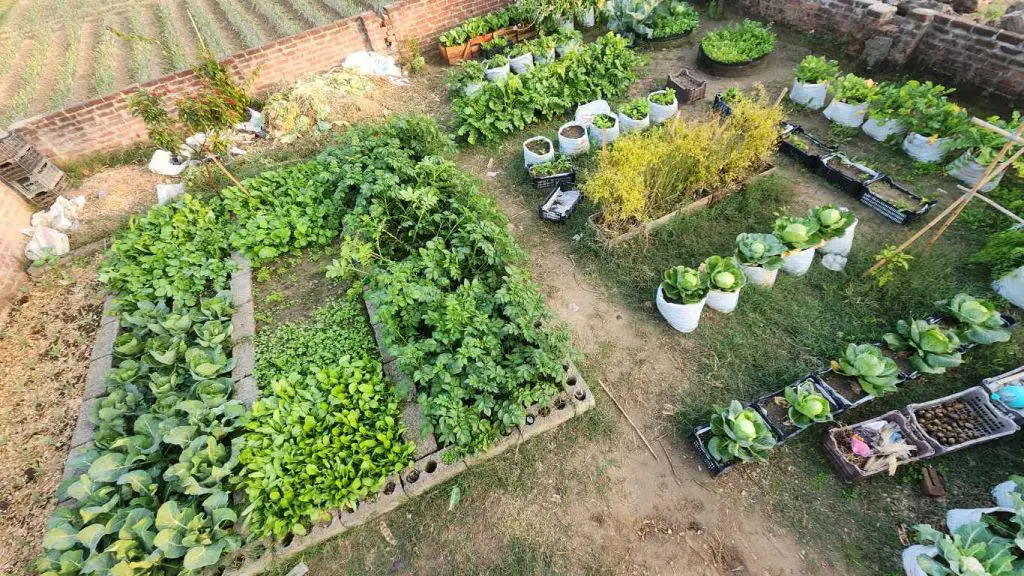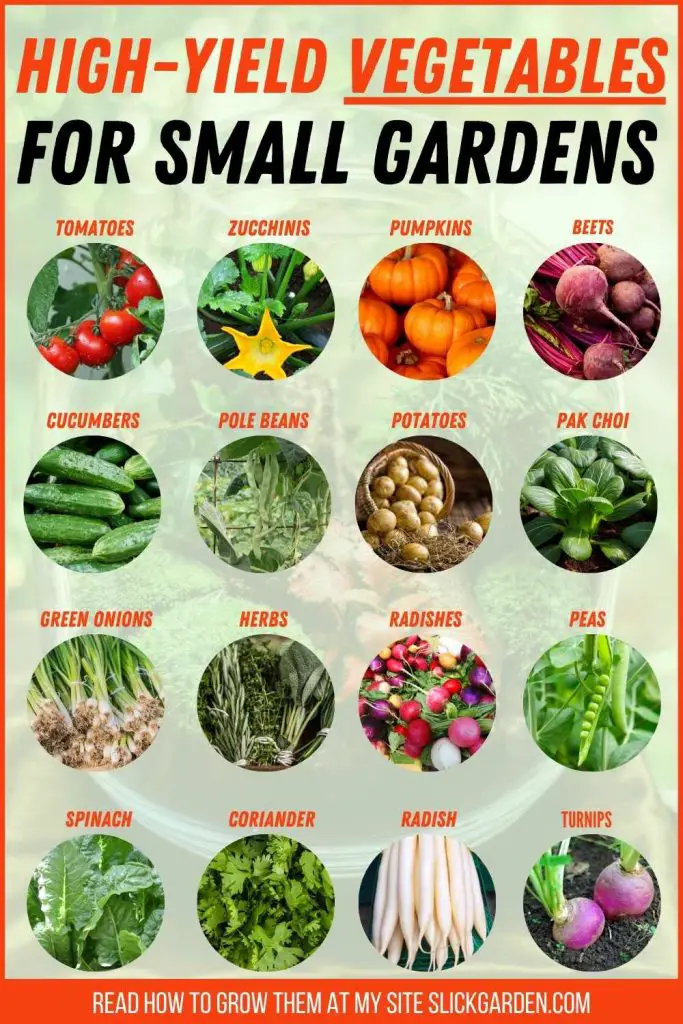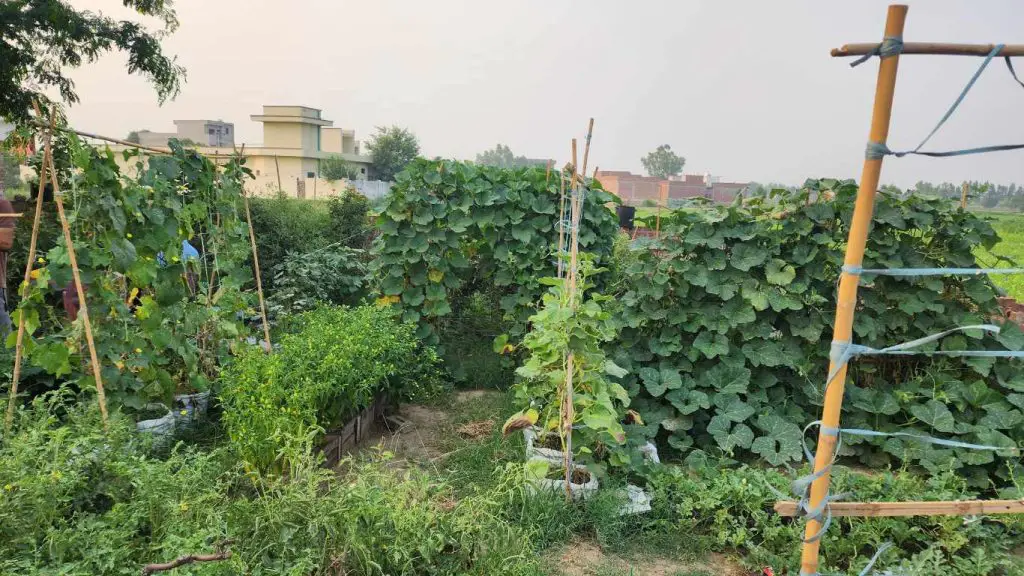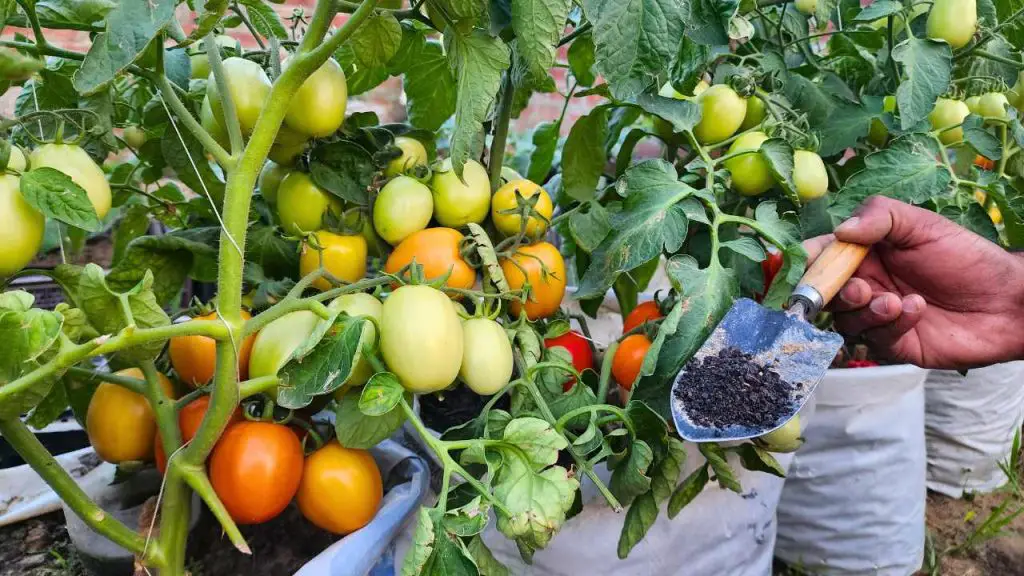If you have a small vegetable garden, it needs proper planning and smart decisions to succeed. To save space and grow more vegetables using the vertical gardening technique can maximize your space and higher yield of vegetables.

What Is High Yield Vegetables?
High-yield crops give you a more valuable harvest within a small space. If you want to get a rewarding amount of yield in unlimited space then you must select crops such as tomatoes and cucumber.
Home-grown vegetables are less expensive and healthy. When you have an abundance of fresh vegetables supply.
Suitable High-Yielding Vegetables For Small Growing Areas

For a small vegetable garden, you must select the right crops to maximize yield. It is better to choose the right compact high-yielding plants that can easily adjust to your climate. Following are some crops that might be suitable for your small garden.
TOMATOES
Tomatoes are an important crop in every vegetable garden as they are high-yielding. Cherry tomatoes are one of the varieties that produce the highest amount of tomatoes for your kitchen.
You must install proper support such as cages or trellis so they will grow well. With proper support, fruits will get fresh air and harvesting will become easier.
For small species, you must select compact varieties such as Beryl Beauty or Champion so easily and just in unlimited. You can get multiple harvests from one tomato plant until frost comes.
Prepare the seedlings indoors by sowing the seed 5 weeks before the last frost date. When seedlings are a few inches tall then you can transplant them in the permanent location of your garden.
Regular watering and feeding will maximize your harvest. Mulching will assist you in keeping the moisture level in the soil. It is suggested that you should pinch the flower buds at the end of the growing season so the remaining tomatoes get the energy to ripen before frost.
ZUCCHINIS
Another vegetable crop that is very easy to grow. If you are looking for a better space-saving crop then you must select climbing zucchinis.
Starting seedlings indoors is the best way of extending your growing period. The planting time of zucchini depends upon the frost date in your area.
If you don’t know about it then you can ask your local nursery. They will provide you with all the information about the first date in the climate you are living in.
You must pick the fruit from the zucchini plant regularly. Never let the fruit become too big because it has a bitter taste. If you leave the fruit on the plant for a long time then it will take all the energy of the plant and it is harder to make new zucchinis.
PUMPKINS
Pumpkins are heavy feeders but they will produce amazing fruit under suitable conditions. If you want the higher yields of any crop then you should not compromise on the requirement of the plant.
The ideal variety for a small Garden is Jack Be Little. It can produce more pumpkins and the size of the pumpkin is 0.5 to 1 lb.
Avoid watering the leaves of the pumpkin plant because it can encourage powder mildew. You should water the plant at the base to prevent your pumpkin plant from this problem.
BEETS
If you want to add colors to your vegetable garden by adding high-yielding crops then you must not forget beets. Keep the soil moist by regular watering because the size of the beat root will become smaller and woody in a dry environment.
You can also apply a layer of mulch to maintain the moisture level in the soil.
CUCUMBERS
Vertical-growing crops such as cucumber need less space and can easily adjust in small growing areas. For higher yield, you can select snack-sized cucumbers. You will get several harvests from one plant.
POLE BEANS
Three pole bean plants need only one square foot. You need three bamboo supports for one plant so it can easily climb up. You will get a surprising yield of pods from one plant for your kitchen.
As you know beans are fully nutritious so you must add them to your vegetable garden. To protect your plants from aphids, you can water them with a spray bottle to remove them from your favorite bean plant.
The ideal time for harvesting the beans is when they are 7 inches long. If they are too long then they lose their flavour.
POTATOES
You will get an incredible amount of yield of potatoes in one square foot. This vegetable plant needs little maintenance and you can also grow it in your containers.
If you want to maximize the yield of potatoes then you can add compost to make soil more rich for healthy growth. In case, if you are growing plants in a raised bed or container then you can use a high-quality potting mix so the roots will become longer and stronger to produce healthy potatoes for you.
PAK CHOI
The other name of this crop is Bok Choi or Chinese cabbage. This is the fastest-growing vegetable in the list of high-yielding vegetable plants. The cold environment is perfect for pak choi and the ideal time of planting is in spring.
GREEN ONIONS
Your garden is small but it should be sunny so the plants get at least 6 to 8 hours of direct sunlight. The next vegetable on our list is green onions. Make sure your garden has fertile and well-drained soil for growing green onions.
If you are growing them in raised beds then you can easily maintain the fertility of the soil. Keep the soil moist for green onions because they have a shallow root system so they dry out very quickly.
Regularly examine the soil if it feels dry then water then water them. You can apply a layer of mulch around the green onion plants. It will help to maintain the moisture level in the soil.
HERBS
For kitchen gardening, you must add herbs as they don’t need a lot of space to grow. If you have a few pots or containers you can grow them effortlessly.
If you have a 6 inches deep container or pot it will be enough for growing herbs because they have shallow root systems. You can easily grow fresh herbs to add flavour to your favourite dishes.
You can grow cilantro, mint, and parsley in one container. These are the basic herbs you can grow but when you start feeling comfortable in growing Herbs then you will try more herbs.
The other herbs you can easily grow in a small space are Oregano, Rosemary, Basil, Chive, Thyme, Sage, Fennel, Lavender, and Cumin.
RADISHES
Radish is a beautiful, nutritious, versatile, and delicious vegetable crop. There are many reasons to select this crop in your small vegetable garden.
They mature very quickly and are ready to harvest. Before planting radishes, it is better to amend the soil so they will get all the essential nutrients.
PEAS
This is a vining plant that likes to grow in cold weather so the ideal time of planting is in spring. When the temperature is between 55 to 65 degrees Fahrenheit the seeds can germinate easily within 7 to 10 days.
If you are living in a hot climate then you can plant the seeds in fall and you will get the yield over the winter. When the plant produces flowers then it is a clear indication that you can pick peas within 3 weeks.
How To Maximize Space In Small Garden?

If you are looking for a bountiful harvest then you should take some essential steps to maximise the space. Following are some ways through which you can grow your favourite vegetables in a limited space.
USE CONTAINERS
This is the best way of growing plants in small gardens. The containers can easily be adjusted on a balcony, patio, or the corner of the yard. You can easily maintain the fertility of the soil when growing plants in the containers.
The interesting fact about container gardening is that you can easily move them to control sun exposure. You can choose compact varieties of different crops so they can easily adjust in the containers. The ideal vegetables for growing containers are cucumber, tomatoes, and herbs.
TRY VERTICAL GARDENING
You can grow more plants in a small space if you use the vertical gardening technique. In this method of gardening, your plants need proper support such as stakes or trellises.
You can also get support from the walls or fences. In this way of gardening, you must choose vining plants like cucumber, peas and beans.
USE RAISED BED
For small vegetable gardens, you must use raised beds for growing your favourite vegetables. This is the best way of growing plants as you can control the quality and drainage of soil.
INTERPLANTING
Another way of maximizing your yield is by planting different vegetables in the same place. You have to do some research on which plants can grow well together.
For instance, lettuce and radish are the best companion plants so you can grow them together.
Helpful Tips For Growing Vegetables In A Small Garden

Homegrown vegetables are fresh and healthy. You should not worry about the small growing area because thinking about small things can be very beneficial for you. Following are some tips that will be very helpful for growing space-saving vegetables.
- You must choose those vegetables that you love the most because you have limited space. Expensive vegetables are also a good option for growing in small spaces as this will save money.
- You can start your growing season earlier by preparing the seedlings indoors and then transplanting them outdoors in your vegetable garden.
- You must like climbing plants as the crow vertically and save space in your garden. Install proper supporting structures for such plants. For instance, cucumbers, tomatoes, and beans need trellises, stakes, or cages to grow upright.
- You can grow herbs in hanging baskets to grow more plants in limited space. This is another way of growing vegetable plants vertically.
- Never grow those vegetable plants that need a lot of space.
- Choose the bush varieties so you can save space.
- You must try to provide a suitable environment for your favorite plants. Choose a sunny spot so your plants get plenty of sunlight. You can’t deny the importance of location.
- Although we have given you a list of veggies that can grow in a small space you should do some research that can easily grow according to your climate.
- Companion planting is another way to get a higher yield. For example, you can plant corn with beansTo improve the richness of the soil, after some research you will come to know which plants are best companions for each other in your vegetable Garden.
- To maintain the moisture in the soil you can apply mulch in your vegetable garden. It will also help to suppress weeds. You can use different organic materials such as leaves, straws, and grass clipping for mulching.
